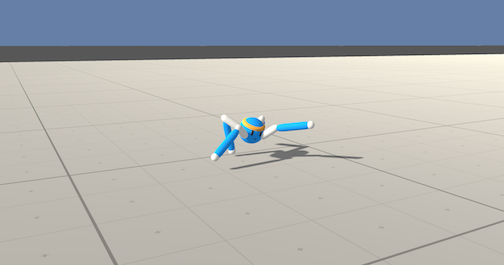Project 1: Navigation Link
Train an agent to navigate (and collect bananas!) in a large, square world.
- Task: Episodic
- Reward: +1 for collecting a yellow banana, -1 is provided for collecting a blue banana.
- State space:
- Vector Environment: 37 dimensions that includes agent's velocity, along with ray-based perception of objects around agent's forward direction.
- Visual Environment: (84, 84, 3) where 84x84 is the image size.
- Action space:
0- move forward.1- move backward.2- turn left.3- turn right.
Project 2: Continuous Control Link
Train an agent (double-jointed arm) is to maintain its position at the target location for as many time steps as possible
- Task: Continuous
- Reward: +0.1 for agent's hand in the goal location
- State space:
- Single Agent Environment: (1, 33)
- 33 dimensions consisting of position, rotation, velocity, and angular velocities of the arm.
- 1 agent
- Multi Agent Environment: (20, 33)
- 33 dimensions consisting of position, rotation, velocity, and angular velocities of the arm.
- 20 agent
- Single Agent Environment: (1, 33)
- Action space: Each action is a vector with four numbers, corresponding to torque applicable to two joints. Every entry in the action vector should be a number between -1 and 1.
Project 3: Collaboration and Competition Link
Train two agents to play ping pong. And, the goal of each agent is to keep the ball in play.
- Task: Continuous
- Reward: +0.1 for hitting the ball over net -0.01 if the ball hits the ground or goes out of bounds
- State space:
- Multi Agent Environment: (2, 24)
- 24 dimensions consisting of position, rotation, velocity and etc.
- Multi Agent Environment: (2, 24)
- Action space: Two continuous actions are available, corresponding to movement toward (or away from) the net, and jumping.
- Target Score The environment is considered solved, when the average (over 100 episodes) of those scores is at least +0.5.
- Modular code for each environment.
- Dueling Network Architectures with DQN
- Lambda return for REINFORCE (n-step bootstrap)
- Apply prioritized experience replay to all the environment and compare while maintaining the modularity of the code.
- Actor-Critic
- Crawler for Continuous Control
- Add Tensorflow graphs instead of manual dictionary graphs for all environments.
- Continuous control Test phase.
- Parallel Environments and how efficient hte weight sharing is
Create a docker Image:
docker build --tag deep_rl .Run the Image, expose Jupyter Notebook at port 8888 and mount the working directory:
docker run -it -p 8888:8888 -v /path/to/your/local/workspace:/workspace/DeepRL --name deep_rl deep_rlStart Jupyter Notebook:
jupyter notebook --no-browser --allow-root --ip 0.0.0.0


